Dell Precision T1600: Workstation Class
by Dustin Sklavos on May 2, 2011 4:55 PM EST- Posted in
- Systems
- IT Computing
- Dell
- Intel
- Xeon
- Precision
- Workstation
- Enterprise
- NVIDIA
Gaming Performance
Truthfully this page is largely irrelevant for a system like the Dell Precision T1600. This isn't a gaming tower; it's meant to be used for heavy duty work. But I can't be the only person who games on their work machine from time to time, and I'm at least personally curious to see what a single-slot, underclocked GF106 can actually do. Right now, the fastest video card available that doesn't require an extra power lead is PowerColor's Green Radeon HD 5750, and the fastest stock card available is the Radeon HD 6670. While I don't have results for the latter, we can at least extrapolate performance of the former from the stock-clocked Radeon HD 5750 in the Puget Serenity.
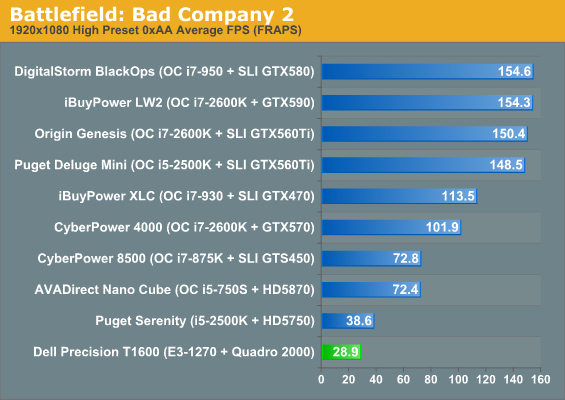


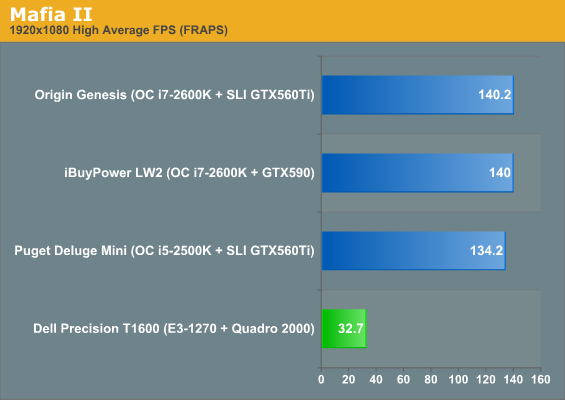
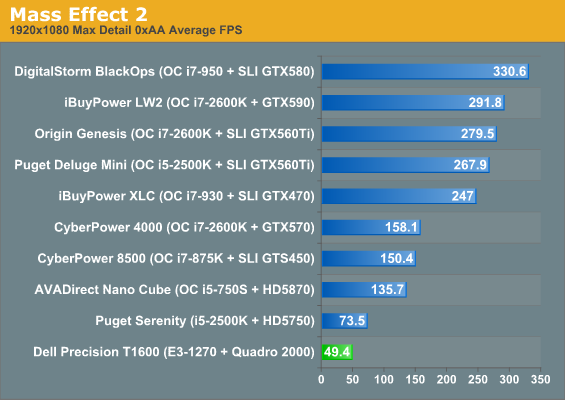
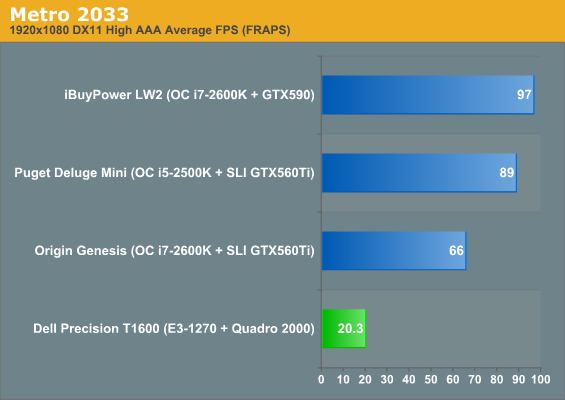
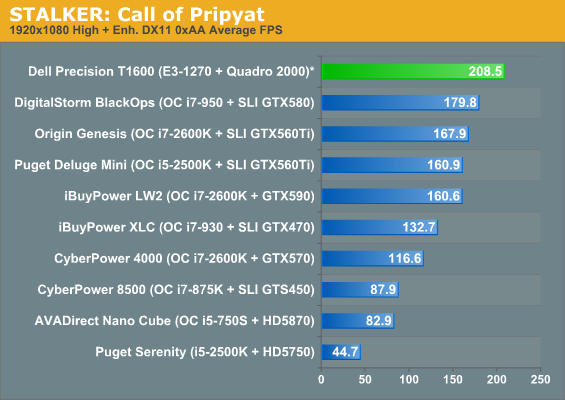
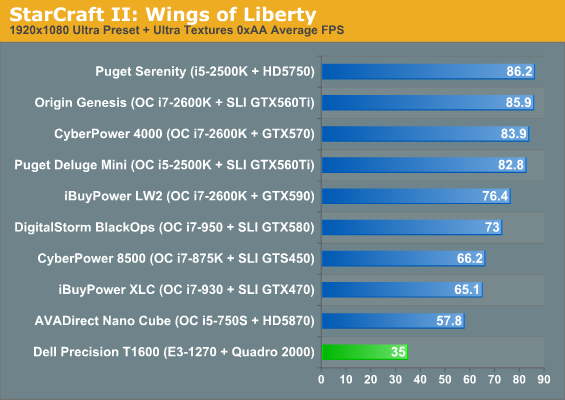
Unsurprisingly it comes in last in every test in our "high" suite except for STALKER, where it inexplicably refused to render any of the post-processing or dynamic shadows (hence the abnormally high score). We left that result there more as a cautionary tale: workstation graphics cards require workstation drivers, and there are optimizations and differences between NVIDIA's Quadro and GeForce drivers that show up on occasion. It appears STALKER is one title where the current Quadro drivers have a bug, and there are bound to be others. The same story would hold true for AMD's FireGL and Radeon lines.
As far as the actual performance, these are pretty challenging settings for anything from a Radeon HD 5770 on down, so most users would want to turn down a few settings. At least the Quadro 2000 could be used for some moderate gaming on a whim, and if you've read our laptop reviews you'll also know that the "poor" results above would rate pretty highly on a mobile system. It's all a matter of your chosen reference point.
UPDATE: The "Ultra" results were removed and the following section added to put the T1600's review more in line with its intended market.
Pricing
The Dell Precision T1600's gaming chops are questionable but that's not what it's there for; again, the exercise was more to see what a single-slot GF106-based graphics card might look like. Try to keep in mind that while the T1600 isn't a gaming machine, it's most definitely a workstation, and the results from SPECviewperf 11 on the previous page are more than double what a consumer-oriented graphics card is liable to produce.
Since an overclock is much harder to curate, workstations are almost never actually overclocked, either. These are gaming systems that have been souped up for their task, but when you put them in a workstation environment, particularly suited to CAD work, they're going to fall behind the Precision T1600. With these things in mind, let's see how pricing breaks down:
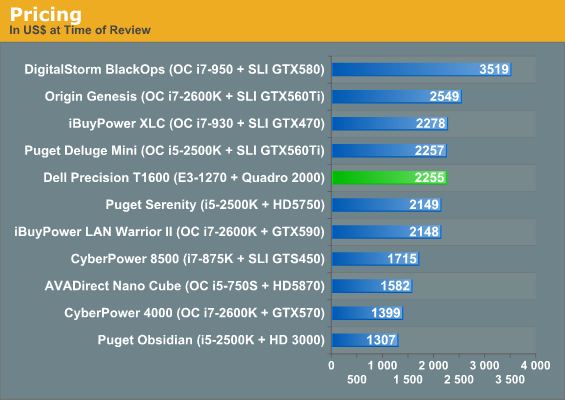
The T1600 is a bit cheaper than some of our overclocked gaming machines and well behind monsters like Origin's Genesis and DigitalStorm's BlackOps. For what you get, though, the price is actually fairly reasonable despite Dell's tendency to overcharge on upgrades.










29 Comments
View All Comments
Michael REMY - Monday, May 2, 2011 - link
good test but why use old cinebench 10 instead the lastest 11.5 release ?mastard - Monday, May 2, 2011 - link
Why were there no test of workstation type applications? Quadro cards are not optimized or intended for games.JarredWalton - Monday, May 2, 2011 - link
Dustin ran SPECviewperf11; if you have any other specific requests for tests, let him/us know.RandomUsername3245 - Tuesday, May 3, 2011 - link
I'd be interested in seeing tests of pro level graphics cards (Quadro & FireGL) in Solidworks and Autocad.**I'd also be very interested in home-grown benchmarks for these programs (perhaps based on CAD models provided from academia or industry) since we've seen both Nvidia and ATI cheat in past benchmarks for gaming cards.**
Stuka87 - Monday, May 2, 2011 - link
Am I the only one that has never heard of the E3 series Xeon chips? Are they a replacement for the 5600 series, or where do they slot in compared to previous gen Xeons?And yes, Dell RAm is laughably expensive. They wanted $430 to go from 4GB to 8GB in my M4500. I bought 8GB from Crucial instead for $97. They also have crazy prices for SSD's.
It would been nice to see some benchmarks from workstation class applications that make better use of the Quadro.
DigitalFreak - Monday, May 2, 2011 - link
No, they're the replacement for the Xeon 3000 series single socket processors. The 5600 series will be replaced by the E5, but not until Q4 this year.Stuka87 - Monday, May 2, 2011 - link
Oh, and a small typo I believe on page 2 after the specview scores:"Quadro 2000 produces scores at least to three times higher than a GeForce GTX 480 would under this test."
Twirrim - Monday, May 2, 2011 - link
Don't know if it counts for this model range but the 3400 series of workstations are pretty hefty, the heaviest workstations I've ever had the 'pleasure' of lugging around anywhere. They put me in mind of the weight of a decent sized CRT monitor rather than a workstation. That said the build quality is very high on them and the devices do look like they can take a serious beating.smilingcrow - Monday, May 2, 2011 - link
I was surprised how basic the heatsink is on this compared to an Optiplex 980 which is a mere business class desktop and not a workstation. That Optiplex has a much larger heatsink and uses a larger fan so potentially could run even quieter.You didn’t seem to give any actual power consumption figures which would be useful especially at idle. I did read that the P/S efficiency is poor but actual measurements are more useful than just quoting the minimum rated efficiency.
dragonsqrrl - Monday, May 2, 2011 - link
4GB of RAM is a bit low for a system running 64-bit Windows 7, especially considering its intended to run memory hungry workstation applications. Running Maya, Houdini, After Effects, Premier, or even Photoshop, I personally wouldn't go with less then 8GB of memory in a new system. Most of these applications could easily eat up ~3GB of RAM running a single instance with a moderate workload. Hope it's not ridiculously expensive for the 8GB upgrade, it's hit or miss with Dell sometimes.